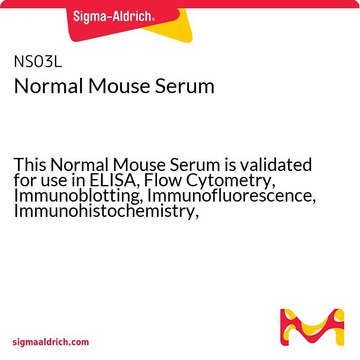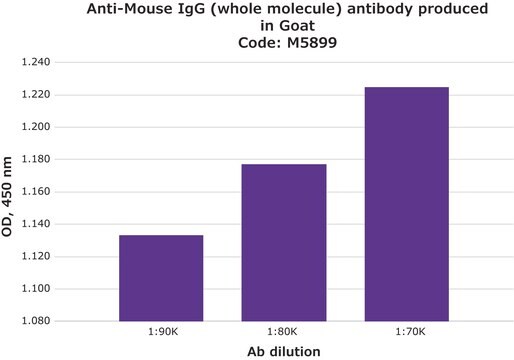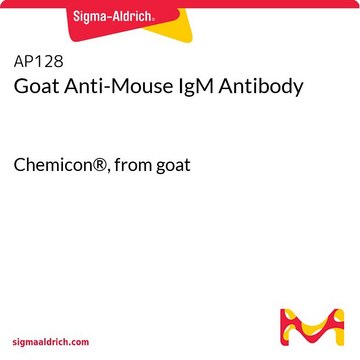M5774
Anti-Mouse Serum antibody produced in rabbit
whole antiserum
Iniciar sesiónpara Ver la Fijación de precios por contrato y de la organización
About This Item
Productos recomendados
origen biológico
rabbit
conjugado
unconjugated
forma del anticuerpo
whole antiserum
tipo de anticuerpo
primary antibodies
clon
polyclonal
contiene
15 mM sodium azide
reactividad de especies
mouse
técnicas
immunoelectrophoresis: suitable
Condiciones de envío
dry ice
temp. de almacenamiento
−20°C
modificación del objetivo postraduccional
unmodified
Descripción general
Mouse serum comprises hormones, antigens, electrolytes and antibodies. It serves blocking agent in immunoassays.
Especificidad
Strong reactivity with normal mouse serum has been determined by immunoelectrophoresis (IEP). This antiserum has not been assayed for interspecies crossreactivity.
Aplicación
Anti-Mouse Serum antibody produced in rabbit has been used in differential fluorescent labelling. It has also been used in differential staining of inner cell mass (ICM) and and trophectoderm (TE) cells. It has been also been used in the removal of zona pellucidae for the isolation of inner cell mass (ICM) from mouse blastocysts.
Anti-Mouse Serum antibody produced in rabbit was used as blocking agent in differential cell count of trophectoderm and inner cell mass cells of mouse embryos.
Forma física
Rabbit Anti-Mouse Serum is provided as a liquid containing 15 mM sodium azide as preservative.
Almacenamiento y estabilidad
For continuous use, store at 2-8 °C for up to one month. For extended storage, the solution may be frozen in working aliquots. Repeated freezing and thawing is not recommended. Storage in "frost-free" freezers not recommended. If slight turbidity occurs upon prolonged storage, clarify the solution by centrifugation before use.
Cláusula de descargo de responsabilidad
Unless otherwise stated in our catalog or other company documentation accompanying the product(s), our products are intended for research use only and are not to be used for any other purpose, which includes but is not limited to, unauthorized commercial uses, in vitro diagnostic uses, ex vivo or in vivo therapeutic uses or any type of consumption or application to humans or animals.
¿No encuentra el producto adecuado?
Pruebe nuestro Herramienta de selección de productos.
Código de clase de almacenamiento
10 - Combustible liquids
Clase de riesgo para el agua (WGK)
WGK 3
Punto de inflamabilidad (°F)
Not applicable
Punto de inflamabilidad (°C)
Not applicable
Elija entre una de las versiones más recientes:
¿Ya tiene este producto?
Encuentre la documentación para los productos que ha comprado recientemente en la Biblioteca de documentos.
Effects of paternal heat stress on the in vivo development of preimplantation embryos in the mouse
Zhu BK and Setchell BP
Reproduction, Nutrition, Development, 44(6), 617-629 (2004)
U Sanmee et al.
Theriogenology, 75(9), 1682-1687 (2011-03-02)
We studied the co-culturing effect of intact and half-destroyed 4-cell mouse embryos on blastocyst formation rate and cell counts. A laser beam was used to produce a hole and destroy an adjacent blastomere in two opposite areas of the zona
Namfon Inna et al.
Clinical and experimental reproductive medicine, 45(3), 110-115 (2018-09-12)
To compare our in-house method of embryo freezing with Cryotop vitrification in terms of immediate survival, subsequent cleavage and blastocyst formation, and cell numbers in blastocysts. Two-cell mouse embryos were randomly allocated into three groups: a non-frozen control group (group
Both the folate cycle and betaine-homocysteine methyltransferase contribute methyl groups for DNA methylation in mouse blastocysts
Zhang B, et al.
Faseb Journal, 29(3), 1069-1079 (2015)
Bi-ke Zhu et al.
Reproduction, nutrition, development, 44(3), 219-231 (2004-10-06)
This study was undertaken to investigate the effects of three media, volume and type of oil and frequency of observation on the in vitro development of mouse zygotes. B6CBF1 female mice (4 to 6 wk old) were superovulated using PMSG/hCG
Nuestro equipo de científicos tiene experiencia en todas las áreas de investigación: Ciencias de la vida, Ciencia de los materiales, Síntesis química, Cromatografía, Analítica y muchas otras.
Póngase en contacto con el Servicio técnico








